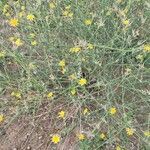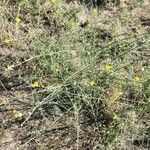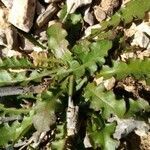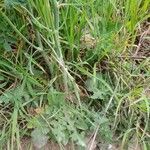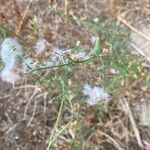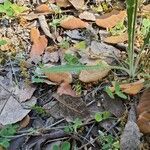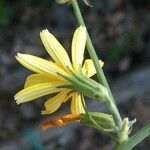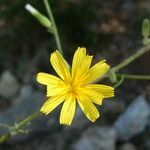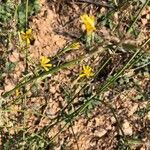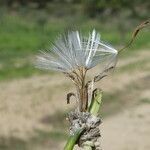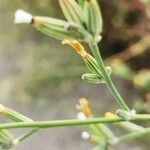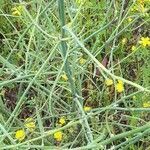Biennial to perennial rosette herb. Stem erect, openly branching above, finely ribbed, with felted tomentum and spreading stiff hairs at the base, glabrous above, 50-80 cm tall. Lvs with scattered fine crisped hairs. Rosette lvs petiolate, oblanceolate to linear, runcinate-pinnatifid, 5-10 × 0.5-2 cm; lobes triangular, acute, distantly finely toothed. Stem lvs sessile, linear, ± entire, c. 3-6 × c. 0.2 cm. Capitula sessile, solitary or in clusters of 2-3. Involucre 9-11 mm long; bracts pubescent to tomentose, erect at flowering, erecto-patent to spreading at fruiting. Florets few. Corolla yellow, c. 11/2× length of involucre. Achenes beaked, glabrous, whitish; body terete or weakly flattened on 1 side, narrowly obconic, 3-3.5 mm long, with spreading flattened scales on ribs, the distal scales forming a corona; beak slender, c. 5 mm long; pappus white, c. 7 mm long.
An erect and much branched herb. It grows up to 1 m high. It keeps growing from year to year or completes its life cycle over 2 years. It develops a long taproot. The leaves near the base are in a ring and are narrow and with lobes which point away from the end of the leaf. The leaves on the stem are scattered. They are narrow and entire. The flower heads are yellow and in the axils of leaves. They have very short stalks. They occur singly or in 2's or 3's. There are 9-15 flowers in a head. Side roots can produce shoots and plants can re-grow from taproots deep under the ground. The seeds have hairs which enables them to blow in the wind.
Branching, rush-like, taprooted perennial with runcinate-pinnatifid, often deciduous basal lvs 5–13 × 1.5–3.5 cm and reduced linear cauline lvs 2–10 cm × 1–8 mm, the stem 3–15 dm, strongly spreading-hispid near the base, the invols white-tomentose, the herbage otherwise glabrous; heads scattered along the branches, commonly with 9–12 fls; invol 9–12 mm, with ca 8 principal bracts; body of the achene 3 mm, muricate above and bearing a circle of scales at the base of the long, slender beak; 2n=15, 30. Roadsides, fields, and waste places; native of Eurasia, intr. in our range from N.Y. to Va., W.Va. and Mich. July–Sept.
Stems with retrorse, coarse, bristly hairs on basal 10-15 cm, distally glabrous. Leaves: basal withered before flowering, blades 5-13 x 1.5-3.0 cm. Involucres 9-12 mm. Phyllaries tomentose. Cypselae: bodies 3-4 mm, beaks 5-6 mm, ribs with antrorse tubercles distally; pappi 5-6 mm.
